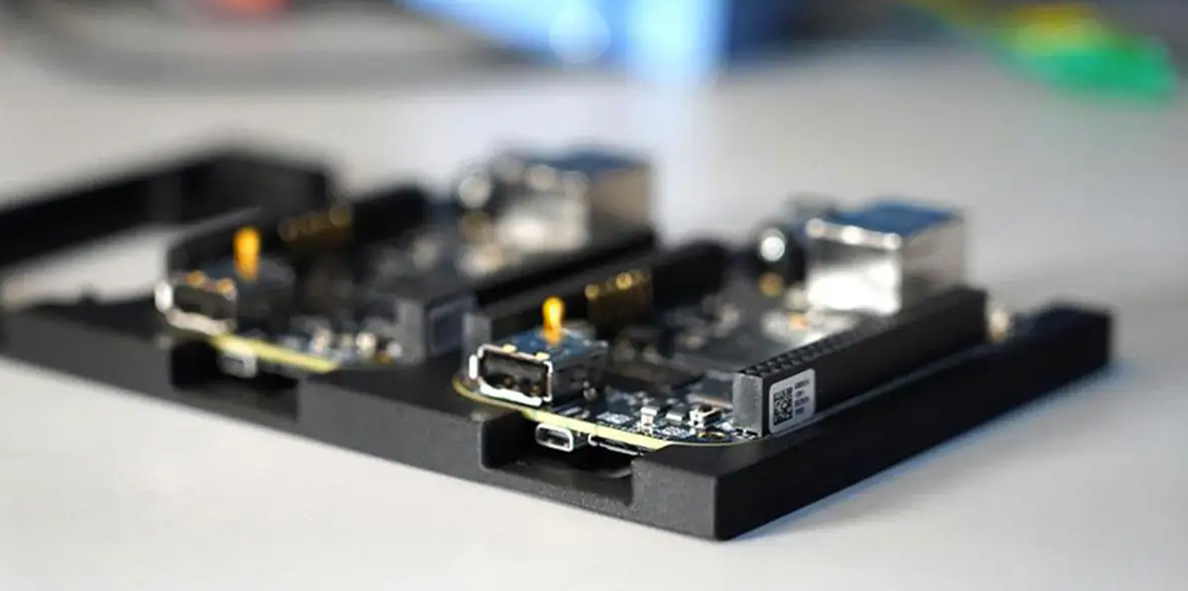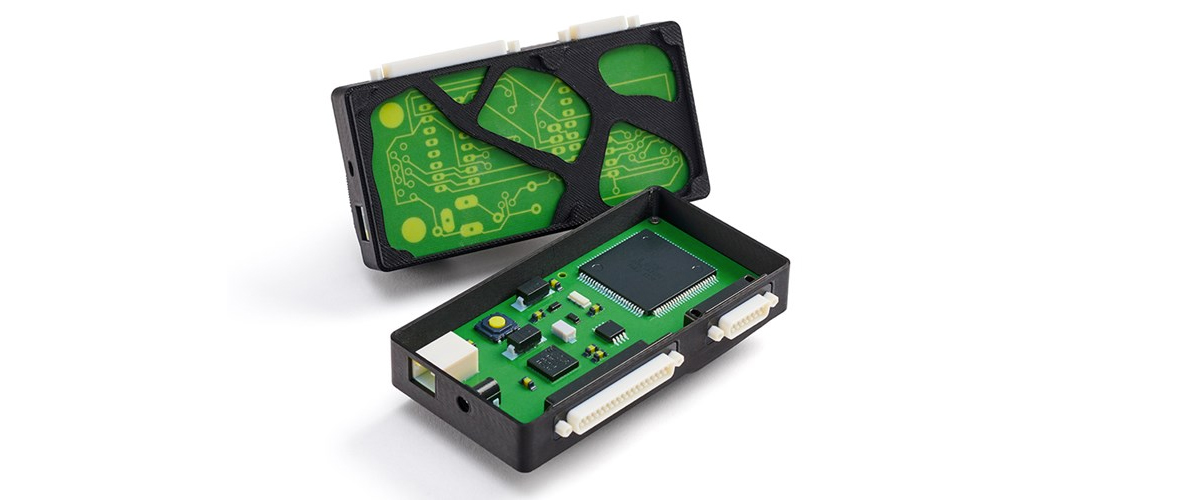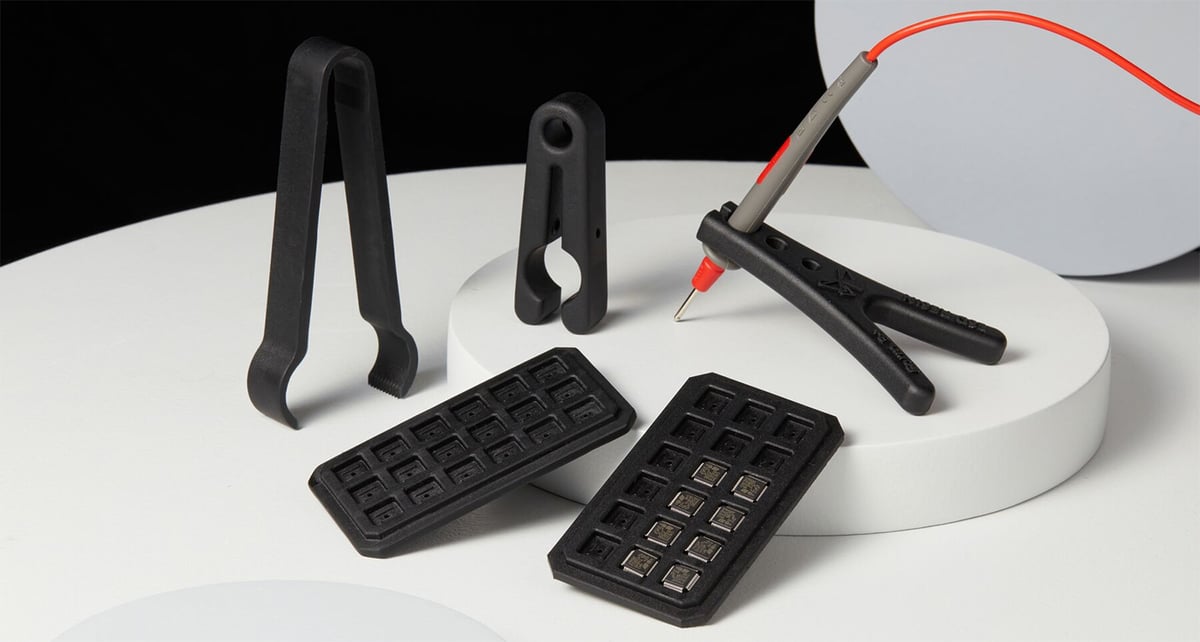Electrostatic discharge (ESD) is an extremely common (think static electricity) but poorly understood phenomenon that causes billions of dollars worth of damage every year to a wide array of electrical components. Most electronics, like your phone, computer, and television, are manufactured with ESD-safe plastic housings and tools, so as 3D printing becomes more popular for making parts used with electronics, the need for ESD-safe materials has boomed.
Fortunately, several ESD-safe 3D printing materials – filament, resin, and polymer powder – have been released onto the market recently. With these materials, you can print circuit board housings, tools and fixtures used in electronics testing, and more parts and products that will protect your electronics from electrical charges.
Here, we’ll explore what ESD-safe materials are, how they work, and when to use them in your 3D printing.
What is Electrostatic Discharge?

When you absolutely need to use ESD-safe materials isn’t always easy to decipher. A thorough understanding of what electrostatic discharge is will help you decide.
If you have ever experienced an electrical shock after touching a metal object, perhaps after walking across a carpeted floor, then you’re familiar with electrostatic discharge. The shock felt, sometimes accompanied by a visible spark, is harmless to you, but destructive to electronics.
When certain materials rub together, a surplus of electrons can form on one of the objects, and a deficit forms on the other, as they move between surfaces. This is called the Triboelectric Effect and the exact way this transfer occurs is still debated by physicists. When one object becomes positively charged and the other negatively charged (this charge can sometimes be stored for a long time), the charge will flow as soon as either of the objects touches a good conductor and until both objects are neutral again (have no charge).

Trying to predict which materials will generate this type of static electricity is difficult, but something called the Triboelectric Series can help. This is simply a list of materials, ranked from those most likely to form a positive charge, to those most likely to form a negative charge. The further away two materials are in the series, the more likely that they will generate static when touched or rubbed together.
The problem for anyone working on electrical products, is that human skin is at one end of the triboelectric series, and most synthetic fibers, such as nylon, are at the other. This means that simply by moving around a normal room, people can create static charges of several thousand volts. If these charges dissipate into, or around, sensitive electronic components, the current can burn out components, or damage internal surfaces, rendering them useless. This is why the tools and housings you use to assemble electronics should be able to dissipate those charges before they reach the sensitive components.
Electrical resistance is a measure of a material’s opposition to the flow of electric current when an electric field is applied. Materials with high resistance are insulators, while materials with low resistance are conductors, allowing current to flow more freely through objects. Surface resistance of a part is measured in ohms (Ω). Materials with a surface resistance rating of 10^6 to 10^9 ohms are dissipative and generally considered safe for use in electronics manufacturing applications.
What are ESD Safe materials?

You may be thinking: Well, plastic doesn’t conduct much electricity, right? True, most plastics have very high resistance to conducting electricity, but the issue isn’t that they conduct electricity, it’s that they are good insulators, which means that the charge is stored and not dissipated.
For a polymer to be deemed ESD safe, an additive, typically carbon, is included that acts to slowly dissipate static charges. This carbon can be added to ABS, PLA, PET-G, PC, PEEK, resins, and a long list of other 3D printing materials.
Does this mean that all carbon-fiber-filled materials are, by nature, ESD safe, you may ask? Unfortunately, no. Each polymer has to have a specific amount of carbon to be ESD safe. Some carbon-fiber-filled materials may meet this level, but if it’s not labeled ESD-safe it most likely isn’t.

When it comes to carbon, either conductive carbon black, carbon fiber, graphene, or carbon nanotubes are added to a polymer to decrease its resistivity and enable it to dissipate an electric current. Of the additive types, carbon nanotubes are the more expensive, but the better option because a smaller amount is required as an additive, which keeps the original material properties closer to the original polymer. Materials that use carbon black need more of it (up to 25%) so it affects the base materials’ print properties. Carbon black can also be abrasive and has the potential to scratch surfaces.
“You may need 15% of conductive carbon black to get the same level of conductivity that you could achieve with only 2-3% of carbon nanotubes,” says Matt Howlett, material scientist and president of filament and 3D printer maker 3DXTech. “If you put 15% carbon black or carbon fiber into PA12, for example, you may achieve the same level of conductivity, but the polymer would be very stiff and brittle, which you may not want in your application.”
Material manufacturers should list their materials’ surface resistance rating range in ohms and may have ISO or other certifications for industries that require a material ESD-safe certified or approved for use in clean electronics manufacturing environments.
When to Use ESD-Safe Materials?

There are a few different instances where ESD safe materials should be considered, and not all of them are related to electronics.
Firstly, and most commonly, when any sensitive electronic components are being assembled, ESD safe materials should be considered for any jigs, fixture, or tool that may be in contact with them. Often metal parts are used, but this is usually expensive, and the hardness of many metals can damage or scratch components. If a component comes in a static-safe bag, then ESD safe materials and practices should certainly be used during assembly. Once assembled, many devices are less-susceptible to ESD damage, but in some instances, it could be appropriate for entire enclosures to be made from ESD safe materials.
In manufacturing environments where there is a fire or explosion risk, a spark can be catastrophic. In these areas, ESD safe parts and components can be essential in preventing accidental ignition of gases, particulates or fuels.
ESD safe parts and components are also very useful for powder-handling, partly due to the flammability of many fine powders, but also due to their tendency to stick to charged surfaces. By using appropriately designed parts with ESD materials, powders will flow smoothly during processing.
Common applications for ESD safe materials:
- Assembly aids for electronics
- Printed circuit boards
- Housings for Raspberry Pi, Arduino, single-board computers, etc.
- Electronic component holders and trays
- Snap-fi t connectors
- Seals, gaskets, suction cups, boots, plugs
- Robotic gribers
- Handheld tools
Printing Tips for ESD Materials

The electrostatic resistance of your printed ESD part will vary depending on the printer’s extruder temperature. Too low and your part could be too insulative (won’t dissipate electric currents). Too high and your part will be too conductive. This is why it’s essential to check the tech specs of your ESD filament. There you’ll typically find a recommended print temperature range.
“We sometimes get calls from customers indicating they are printing our ESD materials and the parts are too insulative,” says Howlett. “We advise them to increase the nozzle temperature 10ºC at a time until they get the conductivity they need. I saw the same effect in ESD plastics for injection molding applications. If the mold was ran too cold, the conductivity would be low and that could be improved by increasing the mold temperature.”
Test your parts for conductivity and adjust your extruder temperature up or down depending on the reading you receive on your part. Fortunately, many ESD-safe filaments come with print profiles for some of the most popular FDM 3D printers, so you have a safe starting point.
What you print may also effect over all conductivity. “Tight raster spacing improves surface conductivity on horizontal surfaces,” says Howlett. Plus, vertical wall conductivity tends to be lower than horizontal wall conductivity.
ESD-Safe Filaments

ESD-Safe Resins

ESD-Safe Polymer Powders

Gerard Shields is the managing director of Printpool Additive Manufacturing Ltd. Gerard is a Masters Degree qualified Mechanical Engineer, and worked in AM in both academia and industry before launching Printpool in 2020. Based in Oxford, UK, Gerard is a specialist in design for additive manufacturing and was recognized as one of the Manufacturer Top 100 and 50 Young People Making Manufacturing Smarter in 2021.
License: The text of "Protect Your Electronics with ESD-Safe 3D Printing Material" by All3DP Pro is licensed under a Creative Commons Attribution 4.0 International License.

